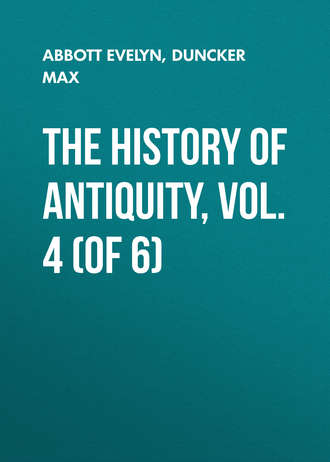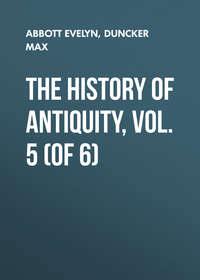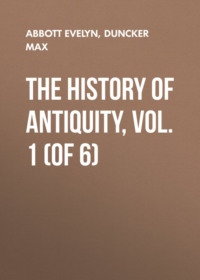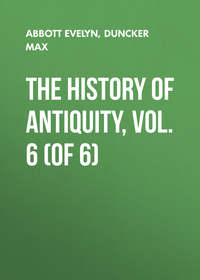 полная версия
полная версияThe History of Antiquity, Vol. 4 (of 6)
654
Strabo, p. 708.
655
Manu, 8, 39, 128, 156, 398, 409; 9, 280, 329-332.
656
Burnouf, "Introd." p. 432.
657
Arrian, "Anab." 7, 4. Droysen, "Alex." s. 396.
658
The date of the campaign of Seleucus can only be fixed so far that it must be placed between 310 and 302 B.C., and as the subjugation of Eastern Iran must have taken up some time, the campaign to India may be placed nearer the year 302 B.C.; we are also compelled to do this by Justin's words (15, 4); cum Sandracotto facta pactione compositisque in oriente rebus, in bellum Antigoni descendit, i. e. to the battle of Ipsus.
659
Justin, 15, 4. Appian, "De reb. Syr." c. 55. Strabo, p. 689, 724. Pliny, "Hist. Nat." 6, 21. Athenæus, p. 18.
660
Diod. Exc. Vat. p. 42. Plut. "Demetr." c. 29.
661
"Açoka-avadana," in Burnouf, "Introd." p. 362.
662
Strabo, p. 70. Athenæeus, p. 653. Pliny, "Hist. Nat." 6, 21.
663
"Dhammapadam," translated by A. Weber, v. 394.
664
Köppen, "Religion des Buddha," s. 294.
665
"Dhammapadam," v. 277.
666
Supra, p. 348. "Dhammapadam," v. 418. Köppen, loc. cit. 289 ff.
667
Burnouf, "Introd." p. 170.
668
Köppen, "Religion des Buddha," s. 131.
669
"Dhammapadam," v. 395.
670
Köppen, "Rel. des Buddha," s. 336.
671
Köppen, loc. cit. s. 338.
672
"Dhammapadam," v. 211.
673
"Dhammapadam," v. 373.
674
Köppen, loc. cit. s. 343.
675
"Dhammapadam," v. 284.
676
"Dhammapadam," v. 315.
677
"Dhammapadam," v. 327.
678
"Dhammapadam," v. 149, 154.
679
"Dhammapadam," v. 343.
680
"Dhammapadam," v. 103, 274, 334.
681
"Dhammapadam," v. 15.
682
"Dhammapadam," v. 308, 312.
683
"Dhammapadam," v. 141.
684
Burnouf, "Introd." p. 274.
685
There are 227 commands and prohibitions among the Singhalese at the present day, and 253 among the Tibetans.
686
Köppen, loc. cit. s. 367 ff.
687
"Dhammapadam," v. 260.
688
"Dhammapadam," v. 270.
689
Schlagintweit, "Buddhism in Tibet," p. 191 ff.
690
"Dhammapadam," v. 20, 94, 181, 412. Cf. v. 267.
691
Köppen, "Relig. des Buddha," s. 411. The supernatural powers of the Arhats are mentioned in the inscriptions of Açoka, and the ordination service of the Çramanas forbade them to boast falsely of supernatural powers. Köppen, loc. cit. s. 413.
692
Köppen, loc. cit. s. 358 ff.
693
"Dhammapadam," v. 300.
694
Supra, p. 339, 357. Köppen, loc. cit. s. 63-118.
695
Burnouf, "Introduction," p. 381. Köppen is undoubtedly right in regarding the worship of relics as older than the worship of images. The worship of relics and pilgrimages was in vogue when Açoka became a convert to Buddhism, but nothing is there said of the worship of images. I do not think it a certain fact that there were no images in the grottoes of Buddhagaya which date from Açoka and his grandson Daçaratha; sockets and niches for images are found there (Cunningham, "Survey," 1, 46), and the images may have been removed later; it is more decisive that in the transference of Buddhism to Ceylon, nothing is said of the transportation of images, though we do hear of relics. Rajendralala Mitra ("Antiq. of Orissa," p. 152), concludes from Panini, who as we have seen lived, according to M. Müller and Lassen, in the second half of the fourth century B.C., that at that time there were little idols of Vasadeva, Vishnu, Çiva, and the Adityas. We may assume that the worship of images came into vogue towards the end of the third century, and afterwards rose rapidly.
696
Burnouf, "Introd." p. 170.
697
Burnouf, "Introd." p. 180, 195, 262.
698
This date would be fixed if the passage in Clement of Alexandria: "The Indians who follow the doctrines of Butta, whom they regard with the greatest reverence as a god," certainly came from Megasthenes. Megasth. fragm. 44, ed. Müller.
699
Burnouf, loc. cit. p. 132, 139.
700
This is the Mahastupa of king Dushatagamani of Ceylon. Lassen, loc. cit. 2, 426, 454.
701
Köppen, "Relig. des Buddha," s. 402, 430.
702
"Dhammapadam," v. 44, 235, 237.
703
"Dhammapadam," v. 105.
704
Köppen, loc. cit. 235 ff.
705
"Dhammapadam," v. 392.
706
Köppen, loc. cit. s. 554 ff.
707
"Dhammapadam," v. 230.
708
"Dhammapadam," v. 141.
709
Köppen, loc. cit. s. 320, 489 ff.
710
"Dhammapadam," v. 251, 202.
711
"Dhammapadam," v. 186, 199.
712
"Dhammapadam," v. 134, 320, 197.
713
"Dhammapadam," v. 106, and at the beginning.
714
"Dhammapadam," v. 70; supra, p. 170 f.
715
"Dhammapadam," v. 177, 306, 224.
716
"Dhammapadam," v. 161, 173, 223.
717
"Dhammapadam," v. 332. Köppen, loc. cit. s. 472.
718
Muir, "Sanskrit Texts," 4, 495 ff.
719
"Mahabharata Çantiparvan," in Muir, loc. cit. 4, 263 ff.
720
Muir, loc. cit. 4, 271 ff.
721
W. von Humboldt, "Bhagavad-gita," s. 41, 57.
722
Rajendralala Mitra, "Antiq. of Orissa," p. 153.
723
Bhagavad-gita, 4, 7, 8.
724
Muir, loc. cit. 4, 151 ff.
725
Muir, loc. cit. 4, 156.
726
Muir, loc. cit. 4, 172 ff.
727
Muir, loc. cit. 4, 495 ff.
728
Muir, loc. cit. 4, 165 ff.
729
"Ramayana," ed. Schlegel, 1, 27.
730
On the variations in the different recensions of the Ramayana in this narrative; see Muir, loc. cit. 4, 444 ff.
731
Muir, loc. cit. 4, 178 ff.
732
Muir, loc. cit. 4, 243 ff.
733
Muir, loc. cit. 4, 182.
734
Muir, loc. cit. 4, 259.
735
Muir, loc. cit. 4, 229.
736
Muir, loc. cit. 4, 216.
737
Lassen's view inclines also to the supposition that Krishna's deification belongs to the time after Buddha, "Ind. Alterth." 22, 822.
738
Muir, loc. cit. 4, 184 ff.
739
Muir, loc. cit. 4, 188 ff.
740
Muir, loc. cit. 4, 205.
741
Muir, loc. cit. 4, 203.
742
Muir, loc. cit. 4, 191.
743
Lassen, loc. cit. 22, 474.
744
Rajendralala Mitra, "Antiq. of Orissa," p. 152. M. Müller, "Hist, of Anc. Sanskrit Lit." p. 46. The name of the Sinha princes, who ruled in Guzerat between 200 B.C. and 25 A.D. (Lassen, loc. cit. 22, 929); Rudrasinha, Rudrathaman, Içvaradatta, prove that the worship of Çiva was in vogue in this region at the time mentioned. The coins of the Turushas exhibit Çiva and his bull, while others bear Buddha's name; Lassen, loc. cit. 22, 842, 843. The coins of the older Guptas exhibit Vishnu's bird Garuda, the goddess Lakshmi, Vishnu's female side, who is churned out of the sea of milk, Rama, and Sita, and Çiva's bull; Lassen, loc. cit. 22, 1111.
745
Arrian, "Anab." 7, 3. Onesicr. fragm. 33, ed. Müller. Plut. "Alex." c. 69.
746
Cf. infra, p. 518. Curt. 8, 9. Plin. "Hist. Nat." 6, 19.
747
Lassen, loc. cit. 22, 467.
748
Burnouf, "Introd." p. 158. Lassen, loc, cit. 22, 467.
749
Aristobulus in Strabo, p. 714. Supra, p. 435.
750
Nicol. Dam. Fragm. 143, ed. Müller.
751
Diod. 19, 33, 34. The narrative is apparently taken from Duris of Samos, who wrote soon after the year 300 B.C.
752
Cic. "Tuscul." 5, 27. Plut. "Vitios." c. 4. Aelian, "Var. Hist." 7, 13.
753
Colebrooke, "Asiatic Researches," 4, 205-215.
754
Lassen puts Yajnavalkya about the year 360 B.C., and Patanjali, the author of the Yogaçastra, between 144 and 124 B.C., loc. cit. 12, 875, 999, and 22, 516. We must also agree with Lassen, that in the theory which Mandanis developes from Onesicritus (frag. 10, ed. Müller), the principles of the Yoga can be traced. The opposition also in which this Mandanis places himself to Calanus, the adherent to strict asceticism, is in favour of the view. As Panini also mentions the Yoga (Lassen, loc. cit. 12, 878), it was in existence towards the end of the fourth century. In the same way I can only agree with Lassen that the book which bears Yajnavalkya's name, and according to the commentators was composed by a pupil of his, cannot be put earlier than 300 B.C. It is the next oldest to Manu (Stenzler, "Yajnavalkya," s. x.). In it the opposition to the Buddhists is vigorous, the Yoga is presented in a simpler form than in the Bhagavad-gita and Patanjalis, and it is free from the mysticism afterwards adopted into the system. The reign of Açoka and his immediate successors could not give any room for the Brahmans to hope for assistance from the state.
755
Yajnavalkya, 3, 148, 149.
756
Yajnavalkya, 3, 182, 157.
757
Yajnavalkya, 3, 145.
758
Yajnavalkya, 3, 160, 161, 198, 203, 194.
759
"Bhagavad-gita," in Muir, "Sanskrit Texts," 3, 30.
760
"Bhagavad-gita," in Muir, "Sanskrit Texts," 3, 30.
761
Yajnavalkya, 3, 155.
762
Yajnavalkya, 3, 63-66, 155.
763
Yajnavalkya, 3, 195, 196.
764
Yajnavalkya, 3, 191.
765
Muir, loc. cit. 6, 300.
766
Supra, p. 207, n.
767
Yajnavalkya, 1, 271, 272.
768
Yajnavalkya, 2, 185.
769
"Mahavança," p. 21. Burnouf, loc. cit. 1, 364.
770
"Mahavança," p. 34.
771
"Mahavança," p. 26. Burnouf, loc. cit. p. 370, 515.
772
Burnouf, loc. cit. p. 381, 382.
773
"Mahavança," p. 26, 34.
774
"Mahavança," p. 22, 23, 35, 39.
775
Lassen, "Ind. Alterth." 22, 241, n. 4, 245.
776
Lassen, loc. cit. 22, 246.
777
Lassen, loc. cit. 12,649 and 22, 248 regards Aparantaka as the western border land of India.
778
"Mahavança," p. 78 ff.
779
"Mahavança," p. 26.
780
"Açoka-avadana," in Burnouf, loc. cit. p. 415, 426; for these Aryas see above, p. 471.
781
In opposition to Westergaard, who thinks it necessary to put Açoka's accession back to the year 272 B.C., I can only agree with Von Gutschmid that the statements of the Buddhists on the subject require at the most the year 265 B.C. "Zeitschrift D. M. G." 18, 373. On the other hand, from the reasons given above (p. 443), I cannot put Chandragupta's accession at Magadha before 315 B.C. If, therefore, the 52 years which the Buddhists give to Chandragupta and Vindusara are to be maintained, Açoka ascended the throne in 263 B.C. On the other hand, the Brahmans only allow 25 years to Varisara, as they call Vindusara; and according to this the accession of Açoka must have taken place in the year 266 B.C.
782
Cunningham, "Survey," 1, 68 ff; 244 ff.
783
Lassen, loc. cit. 22, 281.
784
"Raja Tarang." ed. Troyer, 1, 101 ff.
785
Lassen, loc. cit. 22, 272.
786
Droysen, "Hellenismus," 2, 611.
787
Lassen, loc. cit. 22, 251.
788
Inscriptions of Girnar, and Kapur-i-Giri, in Lassen, loc. cit. 22, 253.
789
In Ptolemy Κηροβόθρης, Lassen, loc. cit. 11, 188.
790
The inscriptions of Açoka date from various years, or at any rate mention regulations from various years; they speak of the tenth, twelfth, thirteenth, nineteenth, twenty-third, twenty-sixth, and thirty-first years after the coronation. According to the Singhalese the coronation did not take place till the fourth year after Vindusara's death. The inscriptions in which the Greek kings are mentioned date from the thirteenth year after the coronation, i. e. from the sixteenth or seventeenth year of the reign. The festival of the complete adoption of the law of Buddha by Açoka would thus have taken place in the thirteenth year of the reign, i. e. 251 B.C. If the statement of the Singhalese ("Mahavança," p. 22) were correct, that Açoka's consecration did not take place till the fourth year of his reign, which is quite contrary to Indian custom, and seems to have arisen from the desire to make the coronation synchronise with the conversion to Buddhism (according to the "Açoka-avadana," Açoka put on the royal head-dress at the moment when Vindusara died, Burnouf, loc. cit. 364), there would be a chronological difficulty. Alexander of Epirus died about the year 258 B.C.; Magas of Cyrene in that year; consequently both were dead in the thirteenth year after the coronation, the seventeenth year of Açoka, if he ascended the throne in the year 263. The Buddhists have already told us that Açoka showed himself favourable to their religion in the third year after his accession, though it was not till the year 254 or 251 that he formally went over. Hence, arrangements may have been made even earlier with the kings of the West in favour of the spread of Buddhism, and they may have been first mentioned in 251 or 247 B.C. Von Gutschmid, "Z. D. M. G." 18, 373. He might also mention kings of the distant West with whom he had had dealings, though they were dead, especially if he was without intelligence of their death.
791
Lassen, loc. cit. 22, 238.
792
Lassen, loc. cit. 22, 239.
793
"Mahavança," p. 38. Köppen, "Rel. des Buddha," s. 154 ff.
794
Burnouf, "Lotus de la bonne loi," p. 725, 727. Cf. "Mahavança," ed. Turnour, p. 251. A. Weber, "Ind. Studien," 3, 172.
795
Köppen, loc. cit. s. 182.
796
Lassen, loc. cit. 22, 238.
797
Girnar, 6: in Lassen, 22, 267, n. 1.
798
Girnar, 6: in Lassen, 22, 267, n. 1.
799
Delhi, 2: in Lassen, 22, 268, n. 2.
800
Delhi, 2: in Lassen, 22, 272, n. 5.
801
Inscription at Delhi, Lassen, 22, 272.
802
Lassen, loc. cit. 22, 250.
803
Inscriptions at Girnar, 6 and 8.
804
Lassen, loc. cit. 22, 270.
805
Now Buddhagaya to the north-east of the modern Gaya; Cunningham, "Survey," 1, 6, 10 ff.
806
Cunningham, loc. cit. 1, 40 ff.
807
On the elephant pillars at Sankisa, Cunningham, loc. cit. 1, 271.
808
Hiuan-Thsang, in Lassen, loc. cit. 22, 280.
809
Cunningham, "J. R. As. Soc." 13, 108 ff.
810
Lassen, loc. cit. 22, 965.
811
Burnouf, "Lotus de la bonne loi," p. 762. Lassen, loc. cit. 22, 276, 277.
812
"Mahavança," ed. Turnour, p. 72.1
813
Cunningham, "J. R. As. Soc." 13, 112 ff.
814
Supra, p. 370, 371. In consequence of the difference explained above (p. 320, n.) the Singhalese place his reign 62 years too early, from 307 to 267 B.C.
815
Mutu Coomara Dathavança. Köppen, "Rel. des Buddha," s. 517 ff.
816
"Mahavança," p. 171.
817
Stan. Julien, "Hiuen-Thsang," p. 373.
818
Polyb. 11, 34. Supra, 452.
819
Wilson, "Vishnu-Purana," p. 470, 471.
820
Strabo, p. 516.
821
Communication from Prof. Albrecht Weber.
822
Supra, p. 331, n.






